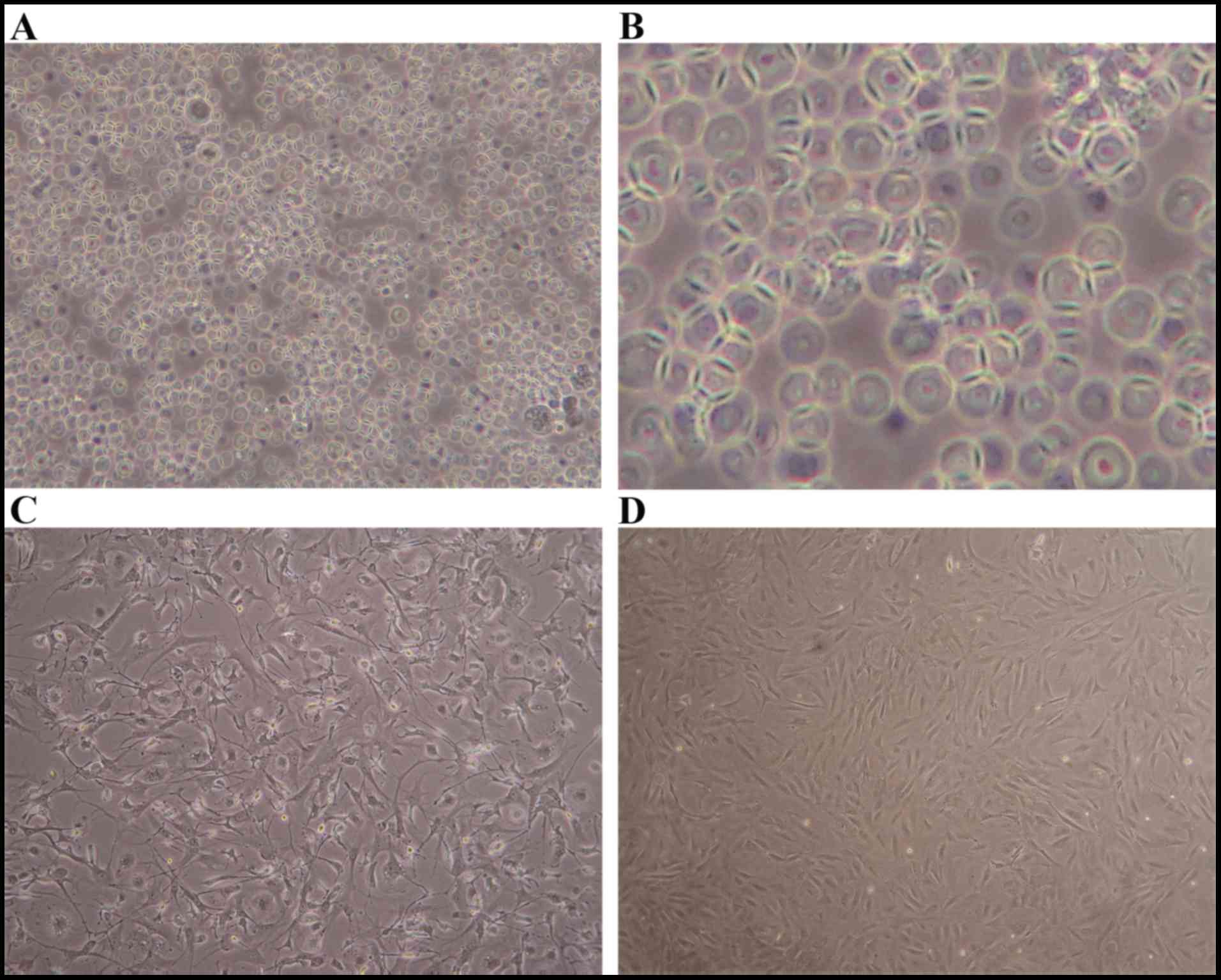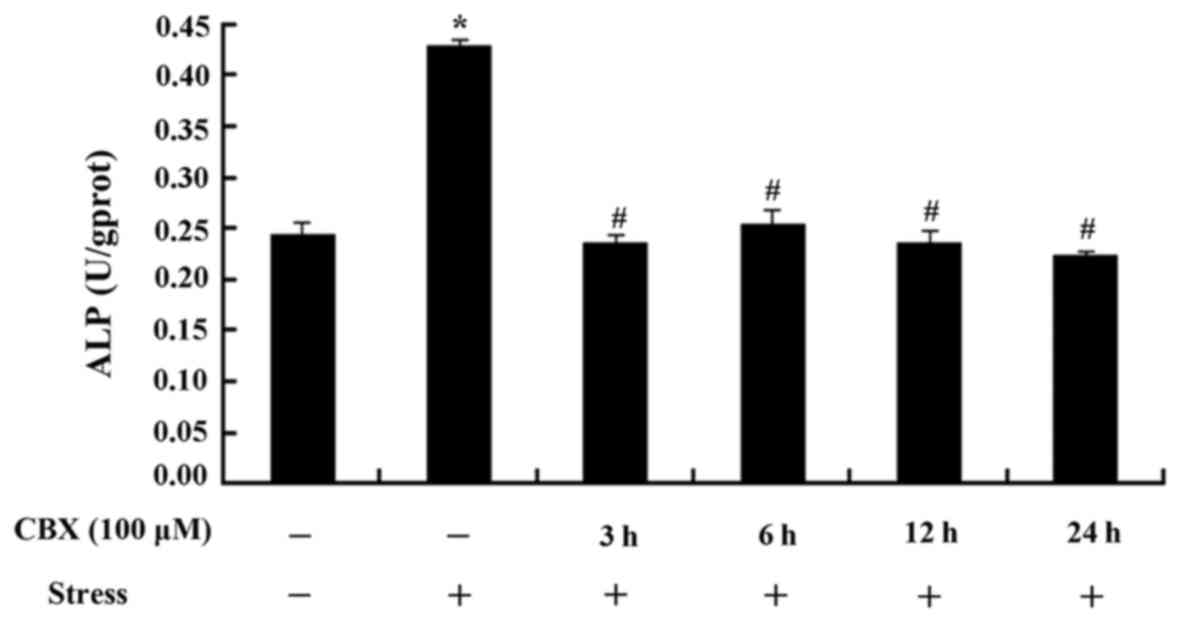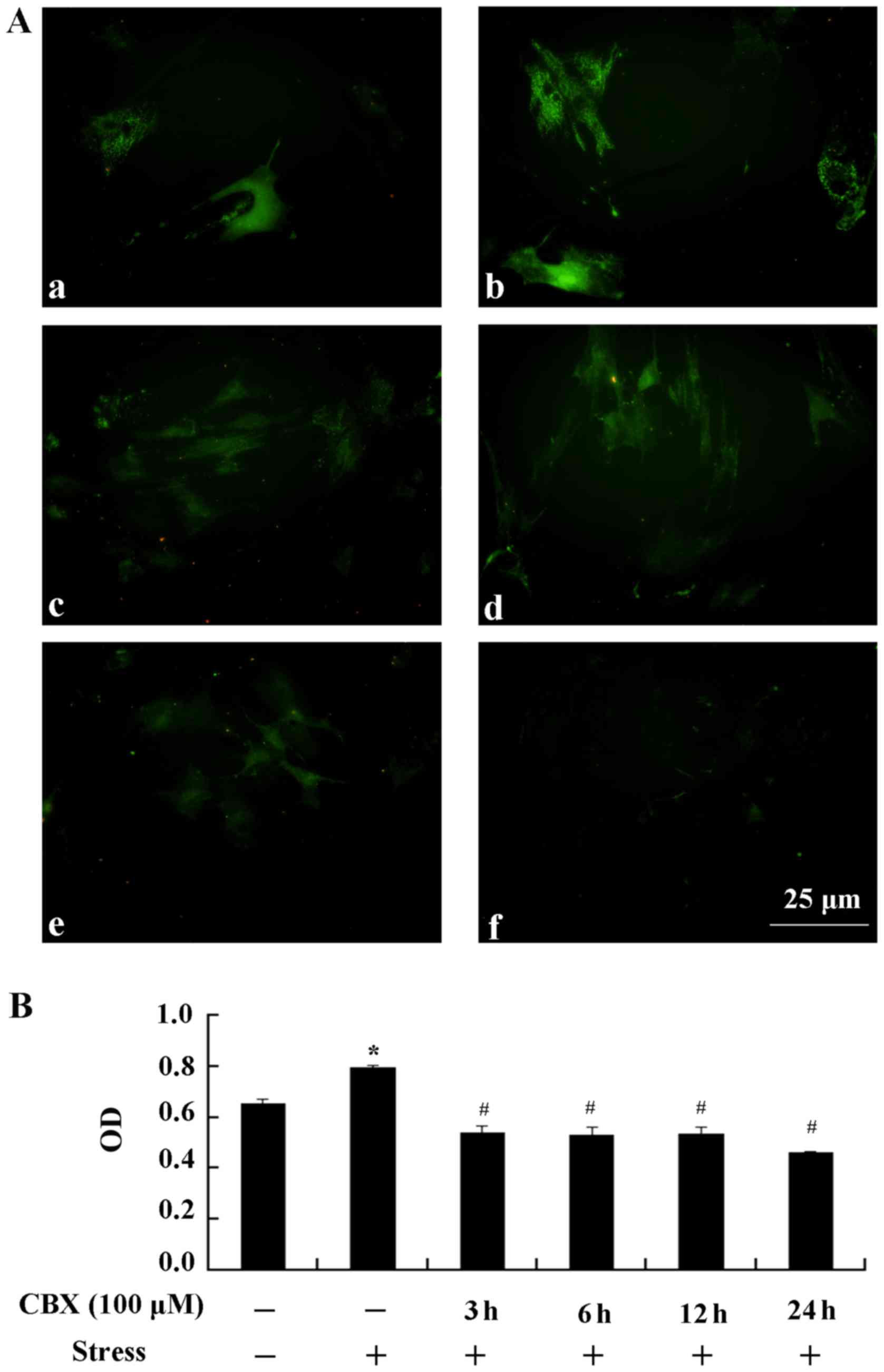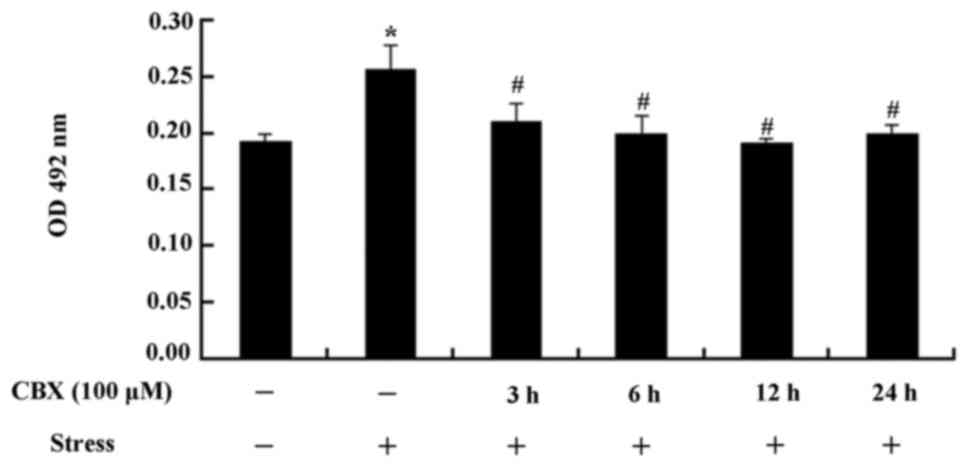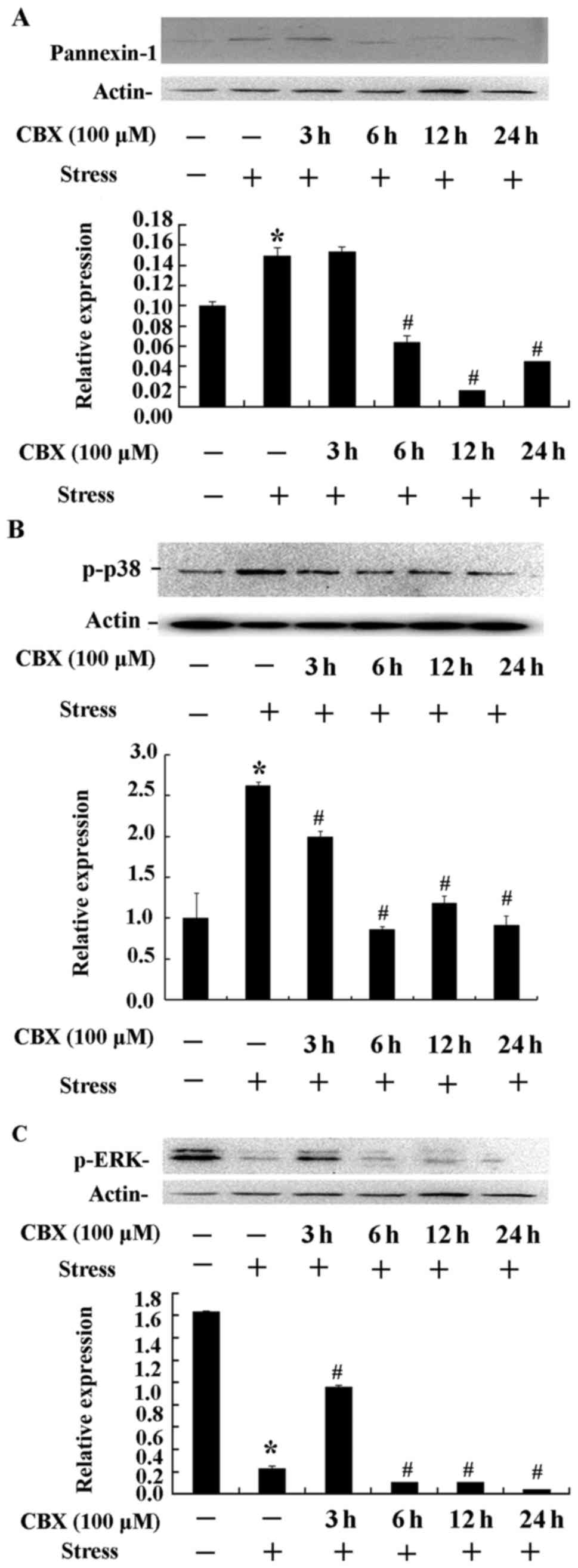Carbenoxolone inhibits mechanical stress-induced osteogenic differentiation of mesenchymal stem cells by regulating p38 MAPK phosphorylation
- Authors:
- Published online on: January 17, 2018 https://doi.org/10.3892/etm.2018.5757
- Pages: 2798-2803
-
Copyright: © Li et al. This is an open access article distributed under the terms of Creative Commons Attribution License.
Abstract
Introduction
Mesenchymal stem cells (MSCs), derived from the mesoderm, have a strong self-replicative ability and multi-differentiation potential. MSCs are used in tissue engineering, cytokines alternative therapy, gene therapy, and other aspects of organ transplantation (1), and as biomaterials in the repair of bone, cartilage, tendons, and glia (2). MSCs differentiate into osteoblasts and then into bone cells, accounting for approximately 95% of bone. Bone cells can act as mechanical stress receptors, and regulate the activities and functions of both osteoblasts and osteoclasts in the form of endocrine cells (3).
A previous study has shown that mechanical stress stimulation promotes osteogenesis (4). Mechanical stress stimuli can cause cell morphology changes, cell projection increases, formation of intercellular gap junctions (GJs), and cytoskeletal structural changes (5). GJs are composed of two adjacent hemichannels which anchor to each other, forming a hydrophilic channel (6) for intercellular communication via small molecules, such as inorganic ions (calcium and potassium), amino acids and glucose (7,8). GJs are dynamic structures, and a variety of factors are involved in regulating their opening and closing, such as intracellular pH, calcium ion (Ca2+) concentration, and membrane potential (9). GJs have functions in cell metabolism and differentiation, transmission of nerve impulses and conduction of information, coordination of consistency between cellular activity, material transport, and electrical excitation conduction (10).
There are three GJ protein families: i) innexin, mainly expressed in invertebrates; ii) connexin, mainly expressed in vertebrates; and iii) a class of genes in vertebrates which are similar to invertebrate innexin, and named pannexin (Px) by Panchina et al (11). There are three Px subtypes: Px1, Px2, and Px3. Px is widely expressed in human tissues and organs, such as osteoblasts, chondroblasts, spleen cells, skin tissues, the kidney, and the central nervous system (12). Px forms hemichannels in the cell membrane, which can be induced to open by hypoxia, low permeability, mechanical stress, cell depolarization, and Ca2+ concentration increases to mediate ATP release and intercellular Ca2+ wave transmission, regulating blood flow or the immune response (13,14). Px1 is a newly discovered mechanical stimuli-sensitive channel protein; however, whether Px1 participates in MSC osteogenic differentiation and signal transduction after mechanical stimulation has been rarely reported. This study aimed to explore the relationship between Px1 channels and MSC differentiation under mechanical stress stimulation, and examine the specific molecular mechanism.
Materials and methods
Isolation and culture of rat MSCs
The Ethics Committee and Animal Management Committee of The First Affiliated Hospital of Dalian Medical University (LCKY20I3-18) approved all experiments. MSCs were isolated from the femurs and tibias of Sprague Dawley (SD) rats (SPF grade, 3 weeks old, weighing 100–120 g). Briefly, rats were euthanized by ether anesthesia with 1.5% pentobarbital sodium (375 mg/kg) followed by cervical dislocation. Muscle tissue and cartilage were removed, and bone marrow suspensions were obtained from marrow cavities using an injector. Subsequently, the bone marrow suspensions were dispersed and centrifuged at 200 × g for 5 min. After removing the supernatant, the pellet was suspended in Dulbecco's modified Eagle's medium (DMEM; HyClone; GE Healthcare Life Sciences, Logan, UT, USA) with 100 U/ml penicillin and 100 U/ml streptomycin (HyClone; GE Healthcare Life Sciences) in a 10-cm dish, and cultured for 48 h. Cell passaging was performed and the third generation was used in the following experiments.
Experimental protocols
First, a safe concentration of CBX (Sigma-Aldrich; Merck KGaA, Darmstadt, Germany) was determined using the CCK8 method according to the instructions provided with the CCK-8 cell proliferation and cytotoxicity assay kit (cat. no. CA1210; Beijing Solarbio Science & Technology Co., Ltd., Beijing, China). This concentration (100 µM) was used for subsequent experiments. MSCs were divided into 6 groups: A control group that was neither stressed nor treated with CBX; a stress group, which was only treated with stress; and four groups that were stressed after CBX treatment for 3, 6, 12, and 24 h. Stress loading was performed using a four-point bending device, as previously described (15). The stress loading strength was 4,000 µ strain with a frequency of 0.5 Hz for 15 min. The treated MSCs were cultured in DMEM with 10% fetal bovine serum (Gibco, Carlsbad, CA, USA) in a 37°C incubator (SANYO, Osaka, Japan).
Detection of alkaline phosphatase (ALP) activity and intracellular ATP content
MSCs were sonicated with an ultrasonic cell disruptor (SENXIN, Shanghai, China) and centrifuged at 13,800 × g for 10 min. The optical density (OD) of the cells was read with a UV spectrophotometer (USA Thermo Electron Corporation, San Jose, CA, USA) at 520 nm. ALP activity was calculated using an Alkaline Phosphatase Assay kit (cat. no. P0321; Beyotime Institute of Biotechnology, Jiangsu, China), according to the manufacturer's instructions. Intracellular ATP content was determined utilizing an ATP bioluminescence kit (cat. no. GN202-01; YPH-Bio, Beijing, China), according to the manufacturer's instructions.
Immunofluorescence observation of type I collagen expression
The expression of type I collagen in MSCs was observed by immunofluorescence. MSCs were fixed in 4% paraformaldehyde at 25°C for 15 min, and then 0.1% Triton X-100 was added for 15 min. After blocking with 5% bovine serum albumin (Beijing Solarbio Science & Technology Co., Ltd.) for 1 h, MSCs were incubated with a rabbit-anti-mouse polyclonal type I collagen antibody (1:500; cat. no. AB765P; Merck KGaA, Darmstadt, Germany) for 2 h and then incubated with DyLight 488 AffiniPure goat-anti-rabbit IgG (H+L) (1:500; EarthOx, San Francisco, CA, USA) for 1 h. After washing thrice with phosphate-buffered saline (PBS), the MSCs were mounted with the anti-quenching sealing agent Fluoromount-G (Southern Biotech, Birmingham, AL, USA) and observed under a fluorescence microscope (Nikon, Tokyo, Japan).
Flu-3AM Ca2+ fluorescence probe to detect the intracellular Ca2+ concentration
Intracellular Ca2+ concentrations were detected using the Flu-3AM Ca2+ fluorescence probe. Briefly, the treated cells were incubated with 3 µM Flu-3AM reagent (Beyotime Institute of Biotechnology, Jiangsu, China, cat. no. S1056) for 15–60 min at 37°C. After washing thrice with PBS, the cells were reincubated once to ensure the complete conversion of Flu-3AM to Flu-3, and observed using a fluorescence microscope (Nikon, Tokyo, Japan).
Western blot analysis
Total proteins were extracted in cell lysis buffer [1% Triton X-100, 100 mM Tris-HCl (pH 7.4), 150 mM NaCl, 1 mM EDTA, 1 mM EGTA, 0.2 mM Na3VO4, 10 mM NaF, Protease Inhibitor (Sigma-Aldrich; Merck KGaA), 0.5% NP-40]. Following centrifugation at 13,800 × g at 4°C for 10 min, the supernatant was collected. The protein concentration was estimated by Bradford assay utilizing a Bio-Rad Protein Assay Kit II (cat. no. 5000002; Bio-Rad Laboratories, Inc., Hercules, CA, USA). Further, 50 µg of total protein was separated on 10% sodium dodecyl sulfate-polyacrylamide gel electrophoresis (SDS-PAGE). Subsequently, the proteins were transferred onto polyvinylidene difluoride membranes and blocked with 5% skim milk for 1 h at 25°C. Rabbit Px1 polyclonal antibody (1:1,000; cat. no. ab124131; Abcam, Cambridge, MA, USA), rabbit p38 phosphorylation polyclonal antibody (1:1,000; cat. no. ab47363; Abcam), rabbit ERK phosphorylation polyclonal antibody (1:1,000; cat. no. ab214362; Abcam), rabbit anti-mouse polyclonal type I collagen antibody (1:1,000), and β-actin mouse monoclonal antibody (1:5,000; cat. no. AF0003; Beyotime Institute of Biotechnology) were used as primary antibodies, and were incubated overnight with the membranes at 4°C. Subsequently, membranes were incubated with goat anti-rabbit IgG (1:5,000; cat. no. A0208; Beyotime Institute of Biotechnology) or goat anti-rat horseradish peroxidase-conjugated secondary antibodies (1:5,000; cat. no. A0192; Beyotime Institute of Biotechnology) for 2 h at 25°C. Finally, proteins were detected using the ECL Plus Western Blotting Detection System (GE Healthcare, Little Chalfont, UK) and visualized using the Bio-Rad gel imaging system (Bio-Rad Laboratories, Inc.). Bands were analyzed using Labwork 4.6 software (UVP Products, Upland, CA, USA).
Statistical analysis
Data are expressed as the mean ± standard deviation (SD). Differences within groups were analyzed utilizing a one-way repeated measures analysis of variance. P<0.05 was considered to indicate a statistically significant difference. SPSS 16.0 software (SPSS, Inc., Chicago, IL, USA) was used for all statistical analysis.
Results
MSCs morphology
Fig. 1 shows the morphology of the MSCs extracted and cultured in whole bone marrow culture. Primary MSCs were initially rounded (Fig. 1A) and then gradually attached and became fusiform (Fig. 1B and C). After the cells were passaged thrice and the confluence reached 80% (Fig. 1D), they were used in experiments.
MSCs ALP activity after treatment with CBX
The stress group showed a significantly higher level of ALP than the control group (P<0.05, Fig. 2). Cells pretreated with CBX showed significantly lower levels of ALP than the stress group (P<0.05, Fig. 2); however, no time-dependent trends were observed.
Expression of type I collagen
Stress stimulation significantly promoted the expression of type I collagen (P<0.05, Fig. 3). When pretreated with 100 µM CBX, type I collagen expression was significantly lower than in the stress group (P<0.05). These results suggest that CBX inhibits the expression of type I collagen.
Detection of intracellular Ca2+
Intracellular Ca2+ fluorescence intensity significantly increased in the stress group compared with the control group (P<0.05, Fig. 4), while the fluorescence intensity dramatically decreased with CBX treatment compared with the stress group (P<0.05, Fig. 4). Of these, the group treated with 100 µM CBX for 24 h showed the lowest Ca2+ level. These results suggest that intracellular Ca2+ exchange is blocked by CBX.
ATP release from MSCs
The release of ATP significantly increased in the stress group compared with the control group (P<0.01, Fig. 5). However, after 6–24 h treatment with CBX, ATP release was significantly lower than in the stress group (P<0.05, Fig. 5). These results demonstrate that ATP release can be reduced by CBX.
Px1 expression and p38 and ERK phosphorylation
As shown in Fig. 6, the expression of Px1 and the phosphorylation of p38 and ERK protein kinases were estimated by western blot analysis. There was a dramatically increased expression of Px1 in the stress group (P<0.01, Fig. 6A). However, stress combined with 6–24 h pretreatment with CBX showed significantly lower Px1 expression than with stress alone (P<0.05, Fig. 6A). These results further confirm that Px1 expression is inhibited by CBX. The stress and stress combined with 3 h CBX treatment groups showed higher p38 phosphorylation (P<0.01, Fig. 6B), while longer CBX treatment (6–24 h) resulted in significantly lower p38 phosphorylation (P<0.05, Fig. 6B). These results indicate that CBX inhibits the phosphorylation of p38. ERK phosphorylation was significantly reduced in the stress group compared with the control group (P<0.01, Fig. 6C). Stress combined with 3 h CBX treatment resulted in dramatically higher ERK phosphorylation compared with the stress group (P<0.01, Fig. 6C), but significantly reduced phosphorylation with longer CBX treatment (6–24 h; P<0.05, Fig. 6C). This suggests that there is no direct link between Px1 and ERK signaling.
Discussion
This study indicates that Px1 closely participates in the process of osteogenic differentiation under mechanical stress. Mechanical stress stimulation increased ALP activity, type I collagen expression, and ATP and Ca2+ release, promoting osteogenic differentiation, and these effects were prevented by the addition of the Px1 channel inhibitor CBX. In addition, a positive relationship between Px1 and p38 MAPK signaling was noted.
ALP, also known as mineralization-associated protein, is critical for mineralization during bone formation (16). Akbari and colleagues demonstrated that ALP can serve as a sign of osteogenic differentiation (17). Ca2+ deposition is regarded as another marker of osteogenic differentiation (18). A rapid increase in intracellular osteoblast Ca2+ concentration occurs in response to external forces (19). Osteoblast cytoskeletal reorganization and gene expression changes are associated with increased stimulation, and are mainly dependent on internal inositol triphosphate-mediated release (20). This increase in Ca2+ results from intracellular Ca2+ release and extracellular Ca2+ flow. In this study, under the stimulation of mechanical stress, ALP activity and cellular Ca2+ concentration were significantly increased in MSCs, indicating the pro-osteogenic effects of mechanical stress. When the Px1 channel was blocked by CBX, increases in ALP activity and cellular Ca2+ concentration were significantly prevented, which might be related to a block in Ca2+ exchange.
ATP is an important energy molecule in cells under physiological conditions, and an important cell-cell signaling molecule. Under conditions of hypoxia, low permeability, cell deformation, and other stimuli such as depolarization, ATP release increases. There are two explanations for this: ATP, like other neurotransmitters, or in conjunction with other neurotransmitters, could be released via vesicles; ATP release could also be mediated through some kind of a channel. Lu et al suggested that connexin-containing hemichannels are involved in ATP release (21). The Px1 channel has been reported to mediate ATP release from taste cells, airway epithelial cells, red blood cells, and other cell types (22–24). Under physiological conditions, certain stimuli, such as mechanical stress and hypotonic solutions, can induce normal cells to release ATP (25). Previous study indicated that Px hemichannels may mediate the release of both ATP and Ca2+ waves (26).
Recent studies have reported the presence of functional GJs between osteoblasts (27,28). The process of phosphorylation and dephosphorylation of GJ proteins acts as a switch for GJ function. In vitro cultured bone cells under stress display increased phosphorylation levels, indicating increased connections between osteoblasts. In addition, GJs participate in the regulation of osteoblast function and signaling. Px hemichannels can be induced to open by hypoxia, low permeability, mechanical stress, cell depolarization, increased intracellular Ca2+ concentration, and other factors (26).
MAPK signaling pathways are important components of intracellular signal transduction and are involved in a variety of cellular processes, and p38 MAPK in particular plays an important role in the process of differentiation into bone cells (29). The p38 MAPK signal transduction pathway controls three stages in the early differentiation of bone cells, including proliferation, extracellular matrix maturation, and matrix mineralization. In the matrix maturation stage, ALP gene expression levels peak as an early differentiation marker. After the onset of osteoblast differentiation, type I collagen secretion peaks, further promoting bone cell differentiation. The p38 MAPK pathway transduces cellular stress signals to promote osteoblast maturation, including the regulation of ALP expression during osteoblast differentiation (29). This study found that mechanical stress could increase the phosphorylation of p38, but this was decreased after pretreatment with a Px1 inhibitor. Thus we speculate that p38 signaling is important for MSC osteoblast differentiation. In contrast, no changes in ERK phosphorylation were observed after Px1 inhibition, indicating that there was no direct relationship between Px1 channels and ERK signaling.
Altogether, our results indicate that Px1 channels might play a crucial role in the process of osteogenic differentiation. Notably, this may involve signal transduction between Px1 channels and the p38 MAPK phosphorylation.
Acknowledgements
We thank the Central Laboratory at Dalian Medical University for experimental support. This study was funded by the Shanghai Pudong New Area Science and Technology Development Fund (grant no. PKJ2013-Y40) and the National Natural Science Foundation of China (grant no. 30973071).
References
|
Awad HA, Butler DL, Boivin GP, Smith FN, Malaviya P, Huibregtse B and Caplan AI: Autologous mesenchymal stem cell-mediated repair of tendon. Tissue Eng. 5:267–277. 1999. View Article : Google Scholar : PubMed/NCBI | |
|
Kopen GC, Prockop DJ and Phinney DG: Marrow stromal cells migrate throughout forebrain and cerebellum, and they differentiate into astrocytes after injection into neonatal mouse brains. Proc Natl Acad Sci USA. 96:pp. 10711–10716. 1999; View Article : Google Scholar : PubMed/NCBI | |
|
Jiang W, Ma A, Wang T, Han K, Liu Y, Zhang Y, Zhao X, Dong A, Du Y, Huang X, et al: Intravenous transplantation of mesenchymal stem cells improves cardiac performance after acute myocardial ischemia in female rats. Transpl Int. 19:570–580. 2006. View Article : Google Scholar : PubMed/NCBI | |
|
Triplett JW, O'Riley R, Tekulve K, Norvell SM and Pavalko FM: Mechanical loading by fluid shear stress enhances IGF-1 receptor signaling in osteoblasts in A PKCzeta-dependent manner. Mol Cell Biomech. 4:13–25. 2007.PubMed/NCBI | |
|
Klein-Nulend J, van der Plas A, Semeins CM, Ajubi NE, Frangos JA, Nijweide PJ and Burger EH: Sensitivity of osteocytes to biomechanical stress in vitro. FASEB J. 9:441–445. 1995. View Article : Google Scholar : PubMed/NCBI | |
|
Trexler EB, Bennett M, Bargiello TA and Verselis VK: Voltage gating and permeation in a gap junction hemichannel. Proc Natl Acad Sci USA. 93:pp. 5836–5841. 1996; View Article : Google Scholar : PubMed/NCBI | |
|
Iyyathurai J, Himpens B, Bultynck G and D'hondt C: Calcium wave propagation triggered by local mechanical stimulation as a method for studying gap junctions and hemichannels. Methods Mol Biol. 1437:203–211. 2016. View Article : Google Scholar : PubMed/NCBI | |
|
Wang J, Ma M, Locovei S, Keane RW and Dahl G: Modulation of membrane channel currents by gap junction protein mimetic peptides: Size matters. Am J Physiol Cell Physiol. 293:C1112–C1119. 2007. View Article : Google Scholar : PubMed/NCBI | |
|
Escalona Y, Garate JA, Araya-Secchi R, Huynh T, Zhou R and Perez-Acle T: Exploring the membrane potential of simple dual-membrane systems as models for gap-junction channels. Biophys J. 110:2678–2688. 2016. View Article : Google Scholar : PubMed/NCBI | |
|
Meda P and Spray DC: Gap junction function. Adv Mol Cell Biology. 30:263–322. 2000. View Article : Google Scholar | |
|
Panchina Y, Kelmanson I, Matz M, Lukyanov K, Usman N and Lukyanov S: A ubiquitous family of putative gap junction molecules. Curr Biol. 10:R473–474. 2000. View Article : Google Scholar : PubMed/NCBI | |
|
Penuela S, Celetti SJ, Bhalla R, Shao Q and Laird DW: Diverse subcellular distribution profiles of pannexin 1 and pannexin 3. Cell Commun Adhes. 15:133–142. 2008. View Article : Google Scholar : PubMed/NCBI | |
|
Penuela S, Bhalla R, Gong XQ, Cowan KN, Celetti SJ, Cowan BJ, Bai D, Shao Q and Laird DW: Pannexin 1 and pannexin 3 are glycoproteins that exhibit many distinct characteristics from the connexin family of gap junction proteins. J Cell Sci. 120:3772–3783. 2007. View Article : Google Scholar : PubMed/NCBI | |
|
Romanov RA, Bystrova MF, Rogachevskaya OA and Kolesnikov SS: Channel activity of recombinant pannexin 1. Biochem Suppl. 5:343–349. 2011. | |
|
Owan I, Burr DB, Turner CH, Qiu J, Tu Y, Onyia JE and Duncan RL: Mechanotransduction in bone: Osteoblasts are more responsive to fluid forces than mechanical strain. Am J Physiol. 273:C810–C815. 1997. View Article : Google Scholar : PubMed/NCBI | |
|
Genge BR, Sauer GR, Wu LN, McLean FM and Wuthier RE: Correlation between loss of alkaline phosphatase activity and accumulation of calcium during matrix vesicle-mediated mineralization. J Biol Chem. 263:18513–18519. 1989. | |
|
Akbari M, Nikbakht M and Sobhani A: Expression of alkaline phosphatase during osteogenic differentiation of rat bone marrow stromal cells. Cell J. 43:94–106. 2001. | |
|
Rodríguez JP, González M, Ríos S and Cambiazo V: Cytoskeletal organization of human mesenchymal stem cells (MSC) changes during their osteogenic differentiation. J Cell Biochem. 93:721–731. 2004. View Article : Google Scholar : PubMed/NCBI | |
|
Ryder KD and Duncan RL: Parathyroid hormone enhances fluid shear-induced [Ca2+]i signaling in osteoblastic cells through activation of mechanosensitive and voltage-sensitive Ca2+ channels. J Bone Miner Res. 16:240–248. 2001. View Article : Google Scholar : PubMed/NCBI | |
|
Feng JJ, Kronbergs A, Fomin VP, Usatyuk PV, Natarajan V and Duncan RL: Protein Kinase C (PKC)-mediated actin disruption regulates [Ca2+]i responses to mechanical load in osteoblasts. FASEB J. 21:A9132007. | |
|
Lu L, Tu J and Ballard HJ: Connexin-hemichannels are involved in acidosis-induced ATP release from skeletal myocytes. Proceedings of the 17th Annual Scientific Meeting of the Institute of Cardiovascular Science and Medicine (ICSM 2013), Hong Kong, China. Journal of the Hong Kong College of Cardiology. pp. 672013; | |
|
Huang YJ, Maruyama Y, Dvoryanchikov G, Pereira E, Chaudhari N and Roper SD: The role of pannexin 1 hemichannels in ATP release and cell-cell communication in mouse taste buds. Proc Natl Acad Sci USA. 104:pp. 6436–6441. 2007; View Article : Google Scholar : PubMed/NCBI | |
|
Ransford GA, Fregien NF, Qiu F, Dahl G, Conner GE and Salathe M: Pannexin 1 contributes to ATP release in airway epithelia. Am J Respir Cell Mol Biol. 41:525–534. 2009. View Article : Google Scholar : PubMed/NCBI | |
|
Krick S, Wang J, St-Pierre M, Gonzalez C, Dahl G and Salathe M: Dual oxidase 2 (Duox2) regulates pannexin 1-mediated ATP release in primary human airway epithelial cells via changes in intracellular pH and not H2O2 production. J Biol Chem. 291:6423–6432. 2016. View Article : Google Scholar : PubMed/NCBI | |
|
Orellana JA, Froger N, Ezan P, Jiang JX, Bennett MV, Naus CC, Giaume C and Sáez JC: ATP and glutamate released via astroglial connexin 43 hemichannels mediate neuronal death through activation of pannexin 1 hemichannels. J Neurochem. 118:826–840. 2011. View Article : Google Scholar : PubMed/NCBI | |
|
Ishikawa M, Iwamoto T, Nakamura T, Doyle A, Fukumoto S and Yamada Y: Pannexin 3 functions as an ER Ca(2+) channel, hemichannel, and gap junction to promote osteoblast differentiation. J Cell Biol. 193:1257–1274. 2011. View Article : Google Scholar : PubMed/NCBI | |
|
Saunders MM, You J, Zhou Z, Li Z, Yellowley CE, Kunze EL, Jacobs CR and Donahue HJ: Fluid flow-induced prostaglandin E2 response of osteoblastic ROS 17/2.8 cells is gap junction-mediated and independent of cytosolic calcium. Bone. 32:350–356. 2003. View Article : Google Scholar : PubMed/NCBI | |
|
Jørgensen NR, Teilmann SC, Henriksen Z, Meier E, Hansen SS, Jensen JE, Sørensen OH and Petersen JS: The antiarrhythmic peptide analog rotigaptide (ZP123) stimulates gap junction intercellular communication in human osteoblasts and prevents decrease in femoral trabecular bone strength in ovariectomized rats. Endocrinology. 146:4745–4754. 2005. View Article : Google Scholar : PubMed/NCBI | |
|
Jaiswal RK, Jaiswal N, Bruder SP, Mbalaviele G, Marshak DR and Pittenger MF: Adult human mesenchymal stem cell differentiation to the osteogenic or adipogenic lineage is regulated by mitogen-activated protein kinase. J Biol Chem. 275:9645–9652. 2000. View Article : Google Scholar : PubMed/NCBI |



